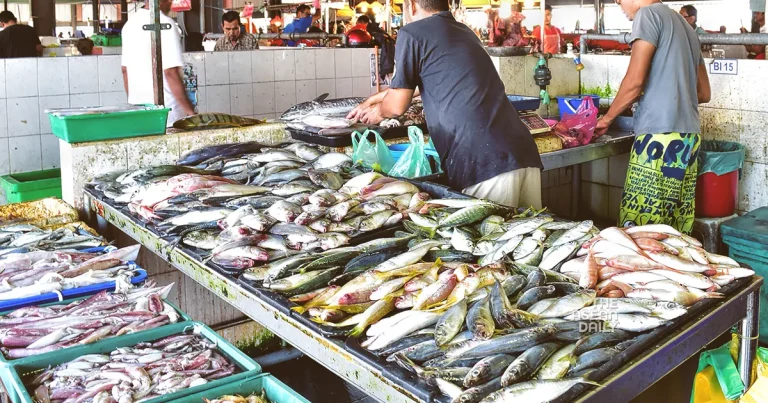13-5-2024 (KUALA LUMPUR) For Ms Izzaty Nabella Lau, a 24-year-old single mother residing in a low-cost flat in Kuala Lumpur, the mounting cost of living has become an unrelenting burden. Several times a month, she finds herself unable to provide adequate sustenance for her three children, let alone afford to send her eldest daughter to primary school.
“After my ex-husband left us, we have nothing. I need to stay home to look after the kids,” Ms Lau revealed, her voice tinged with weariness. The couple’s divorce in 2023 left her household in a precarious state, relying solely on the meagre contributions of her father and two younger brothers for survival. Adding to her troubles, she must also support an older brother afflicted with severe gout, rendering him incapable of working.
Ms Lau’s family of seven resides in a cramped three-bedroom, 645-square-foot flat at the Pantai Ria PPR (Programme Perumahan Rakyat) housing estate in Kuala Lumpur, a flat owned by her father since 2007. Their plight is emblematic of a harsh reality faced by many low-income households in the Malaysian capital.
A recent United Nations report on Malaysia’s underprivileged families has shed light on the staggering statistic that eight out of ten households residing in Kuala Lumpur’s PPR flats are grappling with inadequate income to meet their most basic needs.
The “Living on the Edge” report, released on May 8 by the UN Children’s Fund (UNICEF), polled 755 households across 16 PPR estates in the city between October 14 and November 16, 2023. Its findings paint a grim picture of the escalating cost of living crisis, particularly with regard to food prices, which has impacted a staggering 90 percent of these families.
In contrast, UNICEF’s “Families on the Edge” report, published in 2020 during the COVID-19 pandemic, revealed that seven out of ten households in the same category faced such difficulties at that time.
The latest report highlights dietary shifts among these impoverished households, characterized by an increased reliance on eggs, rice, and instant noodles – the most affordable options available. Approximately seven out of ten households now report spending more on eggs, the most accessible protein source, compared to 52 percent during the pandemic. Similarly, seven out of ten households indicated increased spending on rice, up from four out of ten during the same period.
Dr Muhammed Abdul Khalid, the managing director for research at DM Analytics, the consultancy firm that conducted the study with UNICEF, emphasized that the dire situation in Kuala Lumpur is a sobering indication of the even more severe conditions faced by the poor in other Malaysian states.
“To cope with the escalating expenses, families work harder, cut back on spending, and even reduce their food intake,” Dr Muhammed said. “Their children, who are already facing health challenges, are also eating less, with one out of two eating fewer than three meals per day.”
Nurul Huda Hidayah, a 27-year-old housewife and mother of three, echoed similar sentiments, lamenting that life was undoubtedly easier before and during the COVID-19 pandemic. Living in the same Pantai Ria PPR block of flats, Ms Nurul recalled a time when government assistance was more abundant, and groceries were significantly more affordable.
“When Najib was PM, with RM50, I could buy two whole chickens, a packet of rice, vegetables, sugar and other food items. Now, a packet of rice costs RM25, a kilo of chicken costs RM10,” she recounted wistfully. “This RM50 used to last us a few days, but now, it won’t last us a day. I wish he was back as prime minister.”
The Najib administration, which Ms Nurul fondly remembers, had implemented various assistance programs for the underprivileged, including the Bantuan Rakyat 1Malaysia cash payout scheme, which benefited seven million low-income citizens with RM400 in three payments throughout the year. The Kedai Rakyat 1Malaysia initiative offered cheaper groceries, while Klinik 1Malaysia provided health assistance.
During the COVID-19 pandemic, the Muhyiddin Yassin administration allocated RM4.6 billion under the Special COVID-19 Assistance scheme, benefiting 11 million people.
The current Anwar Ibrahim administration has introduced the Rahmah welfare program, granting households earning less than RM2,000 an annual assistance of RM3,700. However, Ms Lau and Ms Nurul have yet to receive this aid, either due to administrative hurdles or oversight.
The UNICEF study found that 30 percent of households earning RM2,000 or less per month have not received the promised government assistance, exacerbating their already dire circumstances.
Compounding the issue further, the poor often bear the additional financial burden of supporting other members of their extended families, who are also mired in poverty. Ms Nurul’s husband, a technician earning around RM2,000 per month, is the sole provider for her disabled father and housewife mother, with her father receiving only RM900 per month in alms from the Federal Territories Islamic Religious Council.
On May 9, Women, Family and Community Development Minister Nancy Shukri urged the public to alert authorities about children living in poverty, emphasizing that there are more than 130 types of assistance available, and no child should be left behind. Efforts to improve children’s living standards are being discussed at the Malaysian Social Protection Council, while aid rates are being reviewed by relevant government agencies to amend outdated policies and ensure inclusivity for women, the elderly, and the disabled.
In the UNICEF report, Dr Muhammed underscored that the primary demand from the poor is higher wages, followed by increased cash assistance. He suggested that factoring in the cost of living and median wage, Malaysia’s minimum monthly wage should be set at RM2,102 per month, instead of the current RM1,500.




